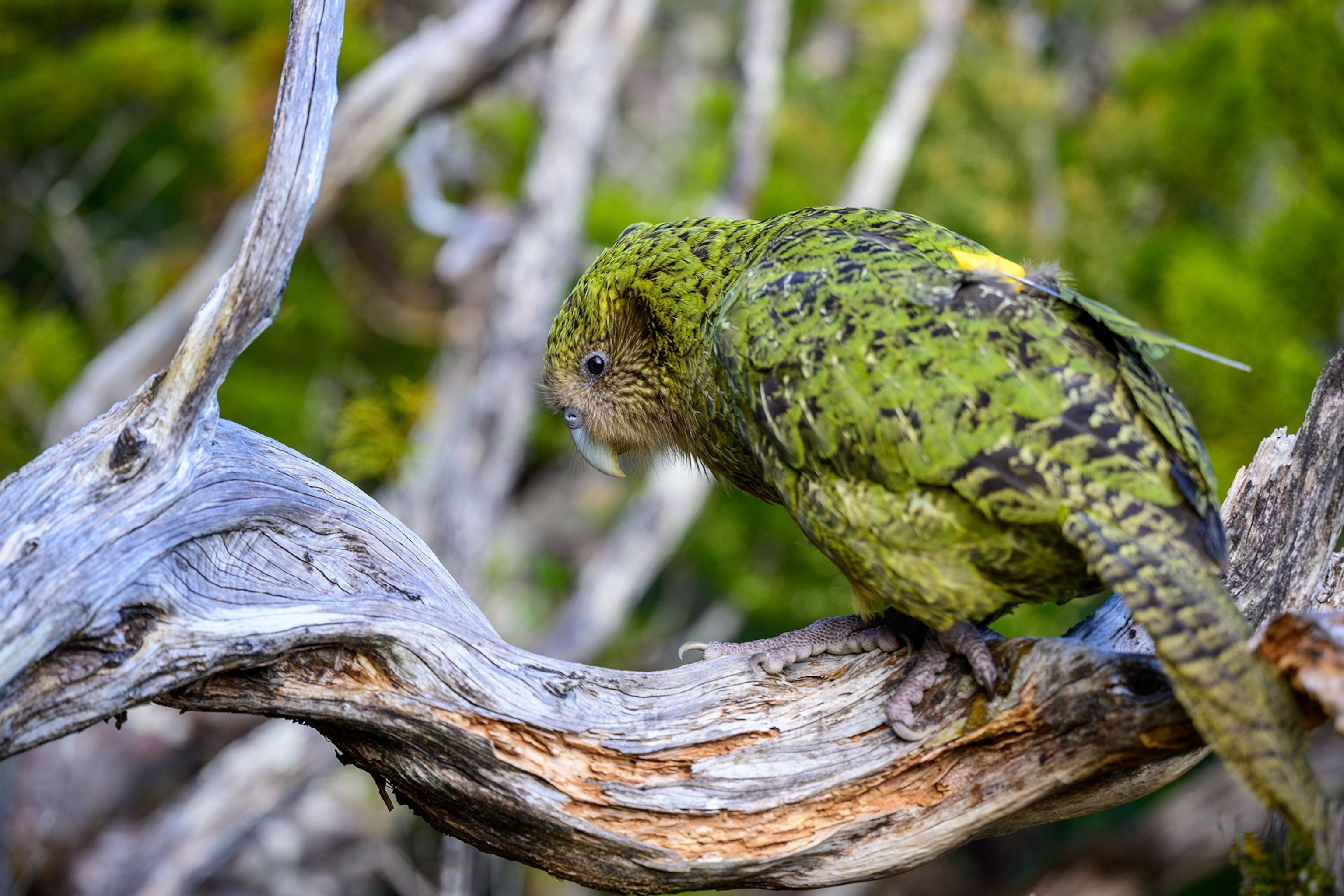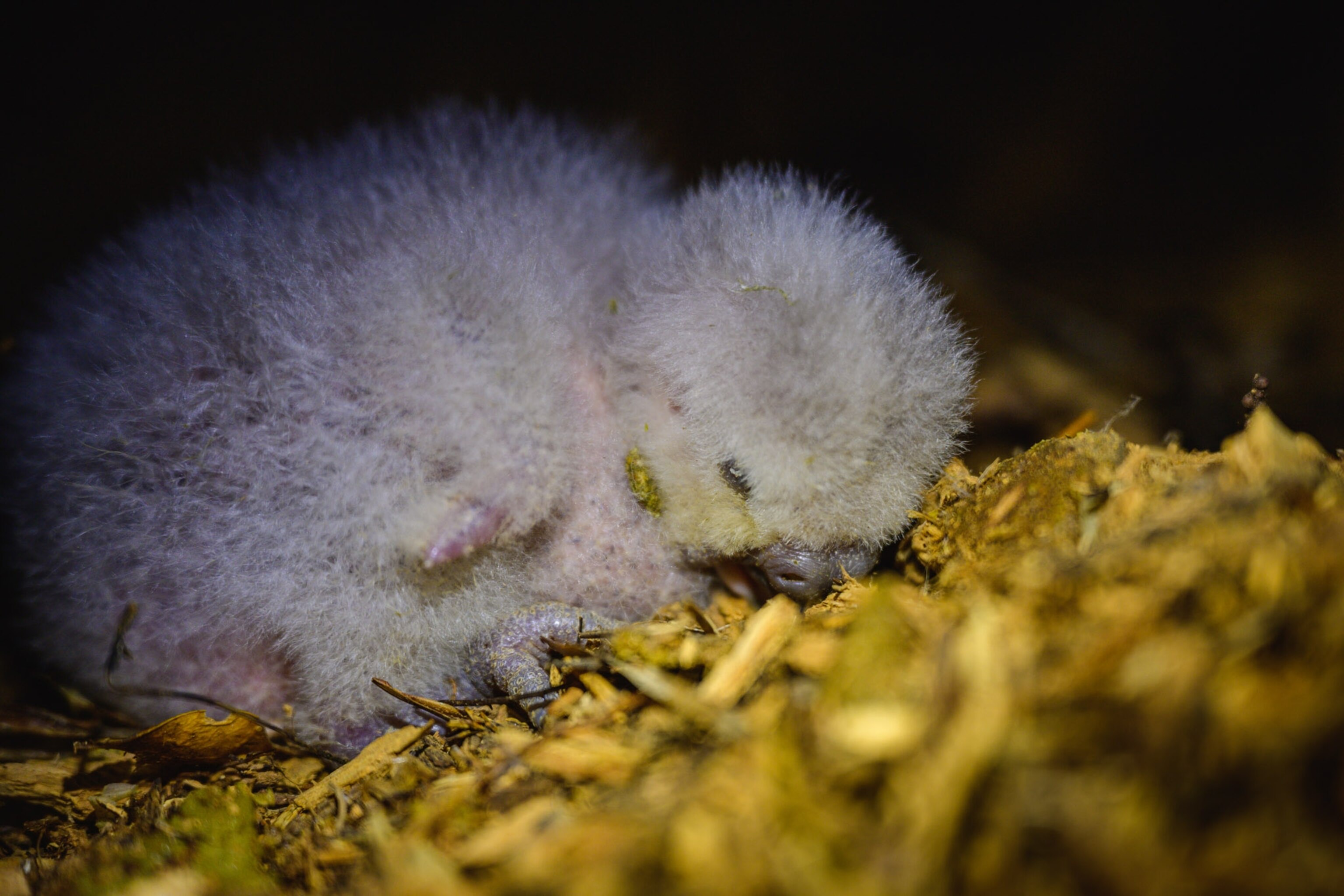
How New Zealand saved a flightless parrot from extinction
Native Maori took a leading role in efforts to revive the iconic kakapo. “People came together because they knew the bird was bigger than anything else.”
In the thick brush atop Sanctuary Mountain, an inquisitive green face poked its head out of a bag. The kākāpō, a moss-colored feather ball named Motupōhue, looked around.
“He’s going to run,” whispered Andrew Digby, a conservation scientist kneeling on the ground nearby and watching closely. As if in response, Motupōhue leapt from the bag and disappeared into the nearby forest, becoming the first kākāpō to step onto either of New Zealand’s two main islands in half a century.
As Digby watched after him, a kōkako, a slate grey native bird, whistled from a nearby tree. Golden beams of light broke through densely clustered supplejack vines and rimu trees. It was a scene that could’ve taken place a thousand years ago, even before the Indigenous Māori first arrived in New Zealand. “This is how things were once,” Digby, who has dedicated the last decade to kākāpō conservation, reflected later. “And how they could be again.”
Kākāpō once lived throughout Aotearoa, the Māori name for New Zealand. Found nowhere else in the world, they have become a national icon, with their muppet-like faces and frequent silliness (in 2009, a kākāpō named Sirocco made global headlines for attempting to mate with a human zoologist in a BBC documentary).
(Scientists are getting creative to save this muppet-faced, flightless parrot.)
But the birds, sometimes called owl parrots, are flightless and slow. On the brink of extinction from imported predators, a few last kākāpō were evacuated to three tiny islets around New Zealand to live free from pests like cats and stoats. There, they also have the constant protection of conservation rangers, who operate under the watchful eye of Ngāi Tahu, the Māori tribe who call New Zealand’s South Island home.
That collaboration has produced a miracle: the kākāpō population has quadrupled in number. To solve the overcrowding that resulted, ten birds were airlifted in July and September to Sanctuary Mountain.
Their story highlights the successes of New Zealand’s bird conservation program, demonstrating how to marry Western and Indigenous conservation approaches, revive endangered species, and reintroduce them to their native land.

Western attitudes, Native values
As a child, Tāne Davis often visited Whenua Hou, the most important of the three kākāpō islands. It is part of the territory, or rohe, of his Māori tribe, Ngāi Tahu. During school holidays, Davis’s father, a crayfisherman, brought him and his siblings along on fishing trips in the frigid ocean that kept Whenua Hou isolated and safe.
From the boat, as Davis stared at the island’s steep shores, his father explained that it was one of the places where Ngāi Tahu first met Europeans: sealers, who arrived around 1810, foreshadowing the wave of settlers to come.
Later, those settlers took over the island. By 1986, the Wildlife Service (later the Department of Conservation) had turned it into a nature reserve and barred members of the tribe from entering without permission.
Eventually, New Zealand’s government faced the country’s iwi, or tribes, over the colonial theft of their land. Ngāi Tahu signed a 1996 settlement giving the iwi a special role in the management of Whenua Hou and, in recognition of the tribe’s centuries-long relationship with the bird, in the conservation of kākāpō.

A Kākāpō Recovery Group was established to oversee the species’ survival, with representatives from Ngāi Tahu, the scientific community, and the Department of Conservation. Davis has been the tribe’s representative since 2006, when he was pushed into taking the role by his mother, a major Ngāi Tahu leader.
Ngāi Tahu’s new position was a dramatic power reversal for the Department of Conservation. It took years to begin reconciling the department’s largely Western attitudes to the tribe’s Indigenous values, and vice versa.
One of the difficult moments in that reconciliation, recalls Davis, was when rangers from the Department of Conservation came to the Kākāpō Recovery Group around 2008 with a novel proposal: to better manage the birds’ breeding, they would artificially inseminate females with manually gathered sperm.
More conservative members of Ngāi Tahu “naturally frowned upon” the idea, says Davis. Many members, including his mother, worried that the procedure was unnatural and might harm the birds.
But there was good reason for this breeding intervention—the birds were becoming so inbred that “eggs just wouldn’t hatch,” Davis told his iwi. The artificial insemination would allow for more genetic diversity. This connected a strange idea to the familiar concept of whakapapa, or genealogy, a key value for Māori. “We seized upon something that connected to Western science,” says Davis, “but at the same time was meaningful to us as a cultural value.”
Over the last two decades, the relationship between Ngāi Tahu and the Department of Conservation has deepened significantly. Now, Davis says, tribe members frequently volunteer on the islands alongside rangers, especially during busy breeding seasons.
The collaboration has been a remarkable success: kākāpō have filled their islands to capacity with 247 across the three sanctuaries.

The kākāpō’s next chapter
In recent decades, Aotearoa has pursued an ambitious goal of eradicating most predators (including rats, mice, stoats and possums—with the exception of cats and dogs), from the country by 2050. Davis, who is actively involved in Predator Free Rakiura, hopes that one day the effort will enable kākāpō to roam around the rest of Ngāi Tahu’s customary lands in the South Island.
In some parts of the country, that predator control effort has allowed the Department of Conservation to release other endangered birds into the wild: late last year it released iconic kiwi into the hills above the country’s capital, and earlier this year it relocated rainbow-feathered takahē into the South Island’s alpine mountains.
The kākāpō are still too vulnerable to take that kind of risk. But the Predator Free campaign has also involved the establishment of immense fenced sanctuaries, one of which is Maungatautari, or Sanctuary Mountain.

Looking for a safe location in which to test whether kākāpō can survive on the mainland, and to relieve overcrowding on the three coastal islands, the Department of Conservation and Ngāi Tahu reached out to Ngāti Korokī Kahukura, one of the iwi local to Maungatautari, to gauge their interest in receiving kākāpō.
In response, Bodie Taylor, a member of Ngāti Korokī Kahukura and the sanctuary manager at Maungatautari, traveled to Whenua Hou. “They were saying, these are like our children,” Taylor recalls. “If you were going to whāngai” – a form of adoption – “your children to another family, you’d want to know the values they hold.”
For a week Taylor and Davis wandered the island together, comparing its trees to those at Maungatautari, watching rangers check the birds, and studying the breeding process. “In getting to know each other, you get to know the iwi, and in getting to know the iwi, you get to know whether you’re ready to adopt the child, or the bird in this case,” explains Taylor.
Over the next seven months, Taylor’s team modified 29 miles of fencing at Maungatautari to prevent kākāpō from climbing out, while scientists and Ngāi Tahu representatives selected ten birds to resettle the old lands.
“Just about everything was unknown,” recalls Taylor. “But people came together because they knew the bird was bigger than anything else.”
Finally, representatives of the various iwi and conservationists like Digby gathered last month at Maungatautari, where they conducted the first release. “We’ve just released kākāpō into a place where they hadn’t been for hundreds of years,” Digby recalls thinking as he watched Motupōhue speed into the bush.
The moment prompted a surge of hope about what might come next. “I’d thought it was going to be a long while before we were releasing kākāpō in unprotected parts of the mainland,” Digby says. “But now I feel it might not be as far off as we thought.”

You May Also Like
Go Further
Animals
- Fireflies are nature’s light show at this West Virginia state parkFireflies are nature’s light show at this West Virginia state park
- These are the weird reasons octopuses change shape and colorThese are the weird reasons octopuses change shape and color
- Why young scientists want you to care about 'scary' speciesWhy young scientists want you to care about 'scary' species
- What rising temperatures in the Gulf of Maine mean for wildlifeWhat rising temperatures in the Gulf of Maine mean for wildlife
- He’s called ‘omacha,’ a dolphin that transforms into a man. Why?He’s called ‘omacha,’ a dolphin that transforms into a man. Why?
Environment
- What rising temperatures in the Gulf of Maine mean for wildlifeWhat rising temperatures in the Gulf of Maine mean for wildlife
- He’s called ‘omacha,’ a dolphin that transforms into a man. Why?He’s called ‘omacha,’ a dolphin that transforms into a man. Why?
- The northernmost flower living at the top of the worldThe northernmost flower living at the top of the world
- This beautiful floating flower is wreaking havoc on NigeriaThis beautiful floating flower is wreaking havoc on Nigeria
- What the Aral Sea might teach us about life after disasterWhat the Aral Sea might teach us about life after disaster
History & Culture
- Scientists find evidence of ancient waterway beside Egypt’s pyramidsScientists find evidence of ancient waterway beside Egypt’s pyramids
- This thriving society vanished into thin air. What happened?This thriving society vanished into thin air. What happened?
Science
- Why pickleball is so good for your body and your mindWhy pickleball is so good for your body and your mind
- Extreme heat can be deadly – here’s how to know if you’re at riskExtreme heat can be deadly – here’s how to know if you’re at risk
- Why dopamine drives you to do hard things—even without a rewardWhy dopamine drives you to do hard things—even without a reward
- What will astronauts use to drive across the Moon?What will astronauts use to drive across the Moon?
- Oral contraceptives may help lower the risk of sports injuriesOral contraceptives may help lower the risk of sports injuries
- How stressed are you? Answer these 10 questions to find out.
- Science
How stressed are you? Answer these 10 questions to find out.
Travel
- Fireflies are nature’s light show at this West Virginia state parkFireflies are nature’s light show at this West Virginia state park
- How to explore the highlights of Italy's dazzling Lake ComoHow to explore the highlights of Italy's dazzling Lake Como
- Going on a cruise? Here’s how to stay healthy onboardGoing on a cruise? Here’s how to stay healthy onboard
- What to see and do in Werfen, Austria's iconic destinationWhat to see and do in Werfen, Austria's iconic destination







